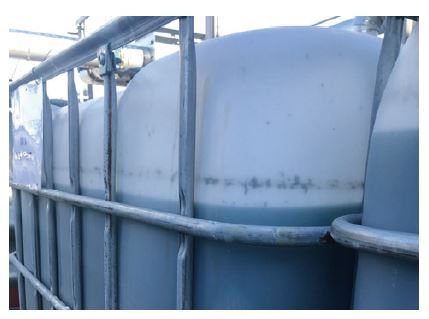GEA Refrigeration UK Ltd, who service and maintain the manufacturer’s refrigeration plant, checked and measured poor performance in one of the chillers; which was due to corrosion and debris in the heat transfer fluid. “It was essential that we completely removed the existing contaminated heat transfer fluid from the secondary circuit, along with any impurities. Before we could refill with new heat transfer fluid, we needed to clean any residue still left in the circuit and needed a powerful, easy-to-use cleaning product for this purpose” said Jeff King, Head of Service at GEA Refrigeration UK in the Spalding Branch.
A challenge met in 24 hours
Dave Richards, Head of Sales for Climalife UK, recommends the use of Desoxyclean* as a first step in removing surface corrosion, scale and sludge from pipes. The advantage of this product is that it can be used on all common materials, including copper, aluminium, steel, stainless steel, brass, iron, rubber, plastic and ceramics. He then recommends Dispersant D* to remove all pollutants from the system.

Once the existing heat transfer fluid had been drained from the system, Desoxyclean was diluted to 100g/l with water and charged into the system. The recommended dilution is 50 to 200g/l. “but we didn’t want Desoxyclean to be too aggressive” said Mr King.
The solution circulated for two hours before being removed. The effectiveness of the product can be seen in the photo below. Initially colourless, the Desoxyclean came out of the installation opaque grey with a lot of residue.
The second step consisted of flushing the circuit with Dispersant D, an essential and effective product for removing non-encrusted suspended metal oxide particles and sludge. The first dose was 50g/l Dispersant D and then a further second flush with a higher dilution of the solution (approximately 25-30g/l). The system was then flushed three times with clean water before being loaded with the new heat transfer fluid.
From Mr King “Both products are simple to use as they mix very easily with water and are packaged in 20kg containers for easy handling,” said Mr King. “It didn’t take long for both substances to work in the system, which was a great advantage as we only had 24 hours to complete the changeover and install modifications to the pipework.”
Friogel® Neo, a benchmark product in the food industry, was chosen as the replacement heat transfer fluid because of its effectiveness against freezing and its inhibitor package offering long-term protection against metal corrosion in the circuits.
Mr King concluded “By carrying out a thorough internal system clean and installing new interconnecting valves between this system and another existing system, we were able to remove the highly contaminated heat transfer fluid and replace it with an industry recognised and widely accepted heat transfer fluid.”
Continuous data collection is underway to measure the performance of the cooling system.
Description of the chiller:
Chiller model: 2x Carrier 30GX227-A0190
Cooling capacity: 1,000 kW at – 4 °C
Quantity of Friogel® Neo: 8,000 litres
Customer benefits:
• Improved the efficiency of the chillers.
• Thorough cleanse of the heat exchangers (evaporators / condensers).
• Peace of mind due to the heat transfer fluid containing corrosion inhibitors.
• The circuit can now be connected to other systems in operation using Friogel® Neo.
*Always read the technical data sheet and safety data sheet before use.

